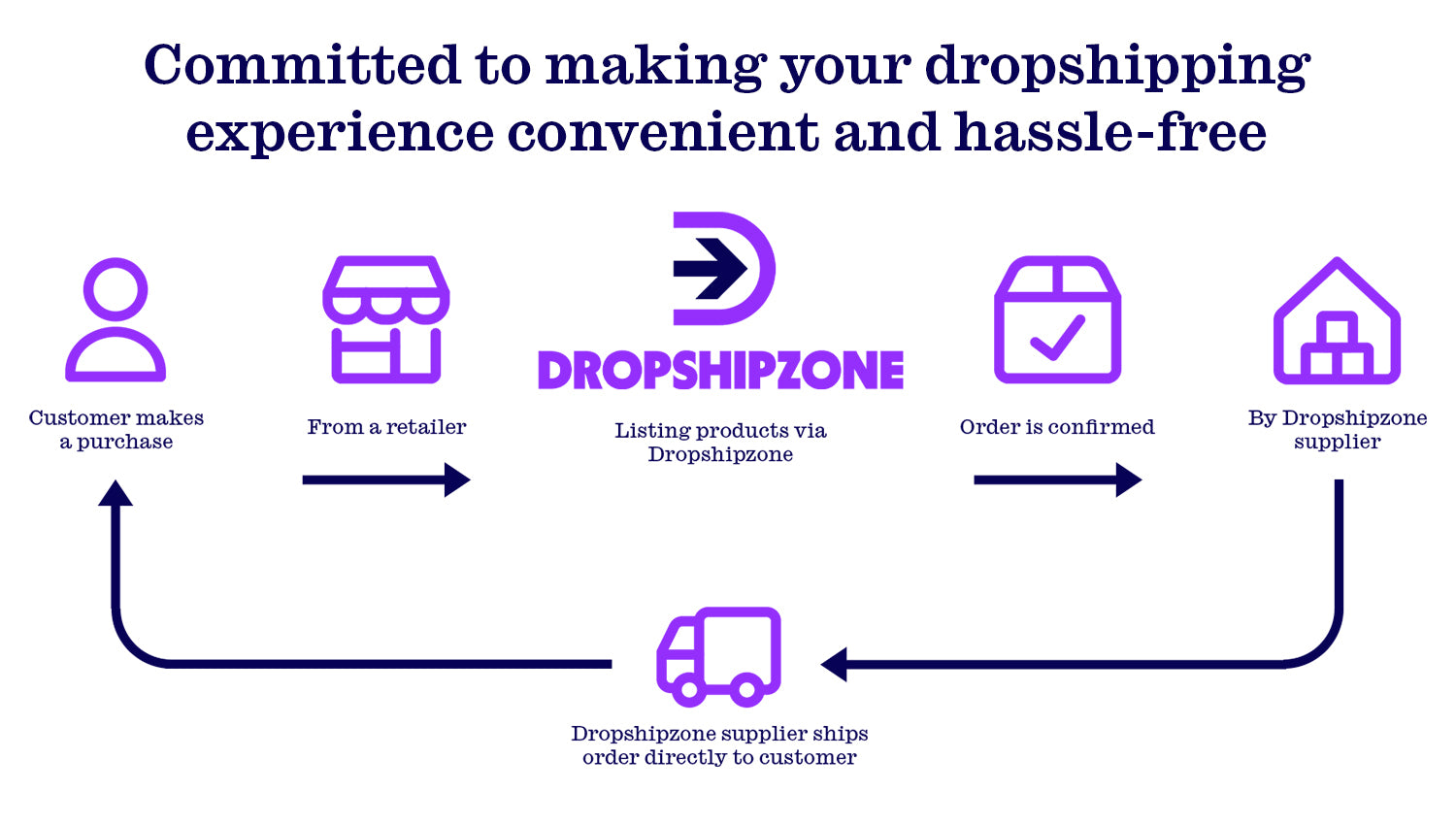
How to Dropship Clothes in 2024
The online share of the fashion retail market in Australia makes up a whopping 25.5 per cent and is expected to reach 38.6 per cent by 2027, so it’s no surprise that clothing is one of the most popular and profitable dropshipping niches of 2024.

Consumers are constantly seeking new styles, trends, brands, and designs, which is why dropshipping clothes makes for an extremely lucrative business idea. It helps you stay on top of the latest trends and offer a wider variety of products without worrying about holding physical inventory. Whether you’re a fashion enthusiast looking to turn your passion into profit or an aspiring entrepreneur exploring the realm of ecommerce, this blog will be your guide to starting and building a successful dropshipping clothing business.
Can you dropship clothing?
If you are looking for a way to make a positive impact on the environment while running a low-risk online business, dropshipping clothing is a great solution if you work with sustainable suppliers. If your business aims to avoid fast fashion and offers eco-friendly shipping options, your dropshipping clothing store will appeal to customers who are passionate about sustainability and reducing their carbon footprint. Dropshipping eliminates the need for physical inventory, reducing waste and minimising your environmental impact so you can start dropshipping clothes and begin your journey towards a more sustainable business model.
Keeping up with the latest trends in clothing can pose a significant challenge for retailers. Fortunately, dropshipping offers a low-risk fulfilment solution that ultimately reduces the overall costs of a traditional supply chain. Additionally, updating your products is easy with just a few clicks, which means you can stay on top of, and sometimes even ahead of, the latest clothing trends without having to worry about having an excess of seasonal clothing, for example, having an abundance of bikinis leftover to sell in the winter.
Dropshipping clothing also allows you to regularly rotate your product offerings, which can have a significant impact on the appeal of your brand to customers. If you’re in the clothing industry, introducing new clothing lines with changing seasons and trends can be an effective way to encourage regular shopping. This is because when it comes to clothing, consumer habits. Brick-and-mortar stores often change their layouts and product offerings to capitalise on this psychology. In the online sphere, changing your dropshipping products can increase the probability of unplanned spending and upselling, as research shows that approximately 40 per cent of online purchases are impulse buys. By dropshipping trending clothing, you can take advantage of these shopping urges and increase the likelihood of repeat purchases.
Is clothing a profitable dropshipping niche?
Clothing is one of the most, if not the most, profitable niches of the 21st century. With the demand for clothing online, this is an extremely lucrative niche when paired with the low-risk business model of dropshipping. The apparel market’s largest sector is Women’s Apparel with a revenue of $16 billion in 2023, a figure that is expected to continue to grow year-on-year.

Dropshipping remains one of the most popular ways to make money in 2024, with 27 per cent of retailers adopting the fulfilment method online. It’s predicted that over the next few years, we will see an increasing shift towards online shopping, meaning now is the time to start your own dropshipping business. However, due to the low barriers to entry when it comes to dropshipping, there are many competitors. This is why choosing a profitable dropshipping niche is imperative to your success as an entrepreneur. You must consider trending products, profit margins, competition, niche longevity, shipping costs and market demands when deciding on your dropshipping niche.
Market research can be conducted to find the most profitable clothing niches. From there, you can work out profit margins to figure out if you’ll have enough to cover the costs of products, shipping costs, and other various business costs.
Trends to consider
Sustainability
Recent research has revealed that an increasing number of online shoppers in Australia – approximately 40 per cent – are opting for eco-friendly and sustainable products over more traditional options. This trend is expected to persist and possibly even grow as more consumers become aware of the importance of environmental sustainability. The landscape of online shopping is rapidly evolving, with consumers placing more emphasis on choosing products that align with their values and beliefs. Businesses that prioritise eco-friendly offerings will likely continue to thrive in the years to come as sustainable businesses become the industry standard.
Working with suppliers who prioritise sustainability is key to achieving environmental goals. One way to do this is by seeking out suppliers who use recyclable packaging and minimal plastics. This can help reduce waste and promote a greener approach to business. Another important step is to implement eco-friendly shipping options, such as carbon-neutral shipping to reduce the carbon footprint of your business.
In addition to these measures, businesses can also make a positive impact by allocating a portion of their profits to sustainable charities and reforestation efforts. This not only supports important environmental initiatives but also helps build a positive reputation and strengthen customer loyalty if customers can see their money is supporting a certain initiative.
Improving your return policy, customer service, and product quality can also have a significant impact on reducing return rates. By ensuring your suppliers have quality products and customers have a positive experience, you can minimise the need for returns and exchanges, which in turn helps to reduce waste and improve sustainability. Overall, these steps can help businesses to achieve their sustainability goals while also enhancing their reputations and customer loyalty.
Personalised shopping experiences
In today’s rapidly evolving retail landscape, online dropshipping stores are increasingly focused on providing personalised shopping experiences and loyalty programs to attract and retain customers. Recent studies show that a whopping 60 per centof consumers are more likely to become repeat customers if their shopping experience is tailored to their unique preferences. If you can nail your website personalisation, you could be looking at a 40 per cent increase in revenue. By leveraging data-driven insights and advanced technologies, dropshippers can create a highly personalised and engaging shopping experience for their customers, driving sales and building brand loyalty in the process.
When it comes to dropshipping clothing, creating a personalised shopping experience for your customers is vital. Some of the most successful personalised shopping experiences aim to mirror the in-store shopping experience where a retail assistant aims to help the customer throughout the shopping journey, from the moment they enter the store, to the fitting rooms, and finally during the checkout process. You can build a virtual fitting room so your customers can find their ideal fit by asking for measurements like height and weight and predicting the perfect size. You can also offer product recommendations during the checkout process based on what a customer has already bought and increase your conversion rate. Not only does this process increase customer loyalty, but it also helps to establish a strong brand identity and reputation in the highly competitive ecommerce landscape.
Best-selling clothing niches
Luxury
The luxury fashion sector has seen a steady increase in revenue, reaching an impressive $4 billion in 2023. Projections indicate that this trend will continue, with a growth rate of 4.67 per cent expected from 2023 to 2028. The allure of luxury items lies in their exceptional quality and longevity, which justifies their high price tags and encourages customers to invest in them. For dropshippers, the luxury fashion niche is particularly lucrative, as it offers higher profit margins and allows for quicker business expansion. However, success in this field relies heavily on working with reliable suppliers and building a loyal customer base.
According to recent surveys, a majority of customers (60 per cent) are planning to make luxury purchases within the next year. Specifically, almost a third of these customers are interested in buying high-end clothing items. In 2021, despite the ongoing pandemic, luxury retail brands in Australia managed to stay successful and continue making profits while other retailers faced things like involuntary administration. This is a testament to the longevity and resilience of this particular niche. Australian consumers are more inclined to attend events where luxury clothing is appropriate than in any other country in the world. Retailers can take advantage of this trend by dropshipping luxury products and marketing them effectively to ensure profitability.

Vintage
Over the past few years, vintage clothing has experienced a surge in popularity, transitioning from a niche hobby to a mainstream fashion trend. With social media platforms such as TikTok and Instagram, users are now able to showcase their op shop finds. There’s also been a rise in celebrities wearing archival pieces on the red carpet. This trend reflects a desire to live in the past and a growing appreciation for the value of sustainable fashion. One of the most significant indicators of the demand for vintage clothing is the success of reseller websites like Poshmark, which boasts an impressive 16 million active users.
The appeal of vintage clothing lies in its unique combination of sustainability, one-of-a-kind items, and nostalgia. Shoppers are drawn to the idea of owning a piece of history and expressing their individuality through their fashion choices. Businesses that sell vintage-style clothing can leverage this trend to their advantage by differentiating themselves from competitors and creating a distinctive brand. Whether they focus on a specific decade or combine various eras, sports teams, or music genres, vintage fashion offers endless possibilities for creativity and innovation.
As Marie Claire noted in an article about the rise of vintage fashion, “This is the new business of old clothes.” The growing popularity of vintage clothing represents a cultural shift towards sustainability and a renewed appreciation for the beauty of the past. As a dropshipper, you may not be able to find suppliers who sell authentic vintage clothing, however, you can still use this trend as a blueprint for the style of clothing that vintage shoppers are looking for.
Activewear
According to recent studies, the activewear market in Australia is expected to reach a valuation of $11.7 billion by 2025. This is a significant indicator of the growing trend of people incorporating activewear into their everyday lives, not just for working out at the gym but also for socialising with friends or running errands. This trend has proven to be lucrative year-round, making it a profitable niche in the retail industry.
In recent years, the trend of healthy living lifestyles has taken social media by storm. With this trend comes an increased demand for activewear. This niche is also now seen as more acceptable for progressive workplaces, and many people consider it their daily uniform due to its comfortable nature. As a result, the activewear niche has carved out a significant place for itself in the retail industry. For retailers, there are two main options: focus on dropshipping clothes for specific activities such as running or yoga or provide an all-inclusive online store for all kinds of sports. This allows customers to find exactly what they need for their preferred activity and allows for a more tailored shopping experience. As the popularity of activewear continues to grow, retailers will need to continue to adapt to meet the changing demands and preferences of their customers, making dropshipping the perfect business solution to avoid losses of profit.
Streetwear
Streetwear has become a popular style choice for those who value comfort and casual style. With a focus on practicality and ease of wear, streetwear staples often include oversized t-shirts, hoodies, baggy pants, sports jerseys, and sneakers. This fashion movement places a high value on quality and durability, which is reflected in the price point. Drawing inspiration from the 1990s and American hip-hop culture, as well as the golden age of Michael Jordan and the iconic Nike Air Jordans, today’s streetwear trends continue to evolve and remain relevant. Dropshipping streetwear is a great way to offer your customers a way to make a statement with comfortable and stylish outfits while creating a versatile and unique brand online.
Instagram is the most dominant social media platform for fashion enthusiasts, with 72 per cent of consumers reporting they’ve purchased after seeing something promoted on the platform. However, TikTok has also gained popularity among fashion lovers as a powerful tool for recording real-time streetwear. Videos showcasing what people are wearing in popular cities such as Melbourne and New York have captured the attention of consumers and inspired them to invest in the latest fashion trends. The streetwear industry has witnessed significant growth in recent years. Australian streetwear giant Culture Kings exploded in 2020 when they saw a turnover of almost 200 million. With careful consideration and strategic planning, this market will prove to be an excellent choice for any retailer looking to make a name for themselves in the industry.
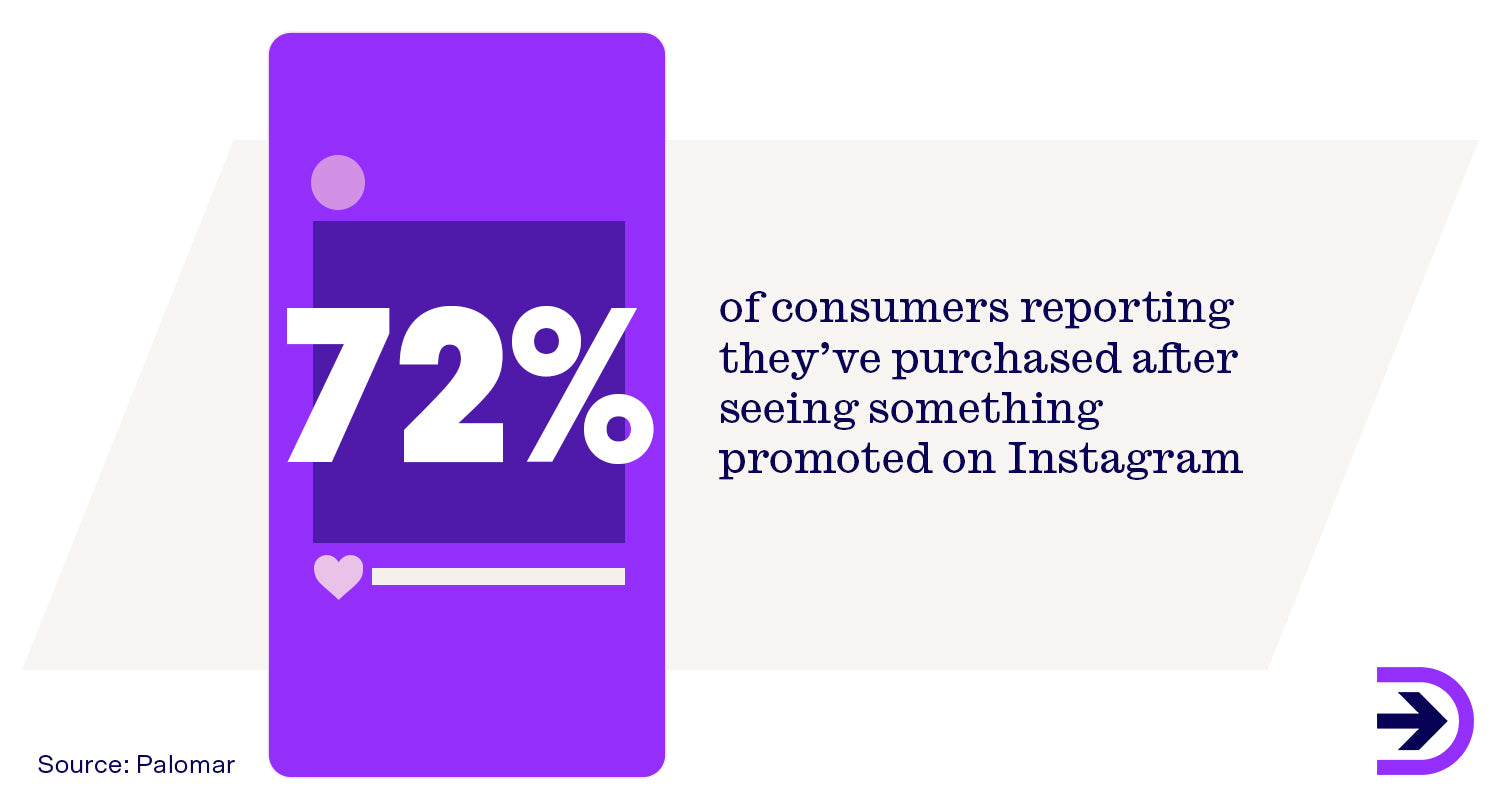
Swimwear
With more than 85 per cent of Australians living within 50 kilometres of the beach, it’s no surprise that swimwear is one of the most popular clothing niches in the Australian fashion industry. Australian swimwear brands are some of the most popular around the globe. However, it is important to note that swimwear is a seasonal item, with search interest peaking in December and experiencing a significant decrease from February to early September. This presents a challenge for retailers who must predict stock levels for the summer season while avoiding excess stock for the rest of the year. Fortunately, dropshipping offers a solution to this problem by eliminating the need to predict stock levels and reducing the risks usually associated with seasonal products. By leveraging this approach, retailers can better cater to their customers while also managing their inventory more effectively.
The upcoming swimwear trends include minimalist and sophisticated pieces that are proving to be timeless additions to customer wardrobes. One-piece swimsuits are becoming increasingly popular with more Australians wanting to take a SunSmart approach to summer. High-waisted bikini bottoms are another trend taking the world by storm, with their flattering and comfortable fit. Additionally, unique styles like cut-out designs, tie-dye patterns, and mesh panels are making an appearance. When it comes to beach and poolside fashion, sarongs, skirts, and dresses will make great additions to your online store encouraging customers to make additional purchases to accompany their swimwear. These pieces provide a versatile and stylish way to cover up and allow your customers to feel comfortable and confident all summer long.
Kids fashion
The global children’s fashion market grew substantially and reached a whopping $386 billion in 2023. The fashion industry for kids has always been trademarked by its vibrant and lively colours, as well as fun and happy patterns. The latest trends in kids' clothing also tend to mimic trends in adult fashion, with more clothing options like wide-leg jeans, cardigans, and graphic tees. Additionally, many children’s stores are taking the initiative to reduce the number of gendered sections of their stores to move towards unisex clothing, especially in the case of baby clothing, promoting inclusivity and diversity.
When it comes to the world of retail, there are several options for those looking to specialise in children’s clothing. Retailers can choose to focus on pre-teen clothing, baby and toddler-aged clothing, or they can opt to cater to both age groups. One area that presents an opportunity for growth in the market is clothing for children aged 8 to 14. These years typically signify a cut-off in the transition from kids to adult clothing sizes and styles, creating an opportunity for a lucrative business venture. This is especially true since the emergence of TikTok, where pre-teens are looking for clothing options that allow them to express their unique style without feeling too childish. These young fashion enthusiasts have struggled to find appropriate stores that cater to their specific needs and preferences. In Teen Vogue's article, the gap in the market for this age group is further discussed, highlighting how social media is playing an increasingly pivotal role in children’s fashion in 2024. Unlike the early 2000s, when Disney Channel stars served as the blueprint for young girls and their fashion choices.
By conducting thorough research and striking the perfect balance, retailers can successfully sell and market their products to tweens. This demographic is eager to explore their personal style and make a statement with their clothing choices, making it an opportune time for retailers to capitalise on the demand with the low-risk nature of the dropshipping fulfilment method.
Custom printed
The pandemic has brought about a significant increase in the demand for custom-printed clothing, specifically t-shirts and hoodies. Shoppers began to look for humorous and feel-good designs to lighten their mood. One brand that has successfully capitalised on this trend is the Australian company Threadheads. They managed to generate an impressive $13 million in a year in revenue by selling t-shirts featuring the famous quote “get on the beers” from a 2020 conference by Victorian Premier Daniel Andrews. Since then, Threadheads has expanded to offer a variety of themes on shirts and jumpers, catering to a wide range of interests, with their latest drop capitalising on the immense popularity of the Barbie movie with the slogan “I am Kenough” ready to print on a variety of products.
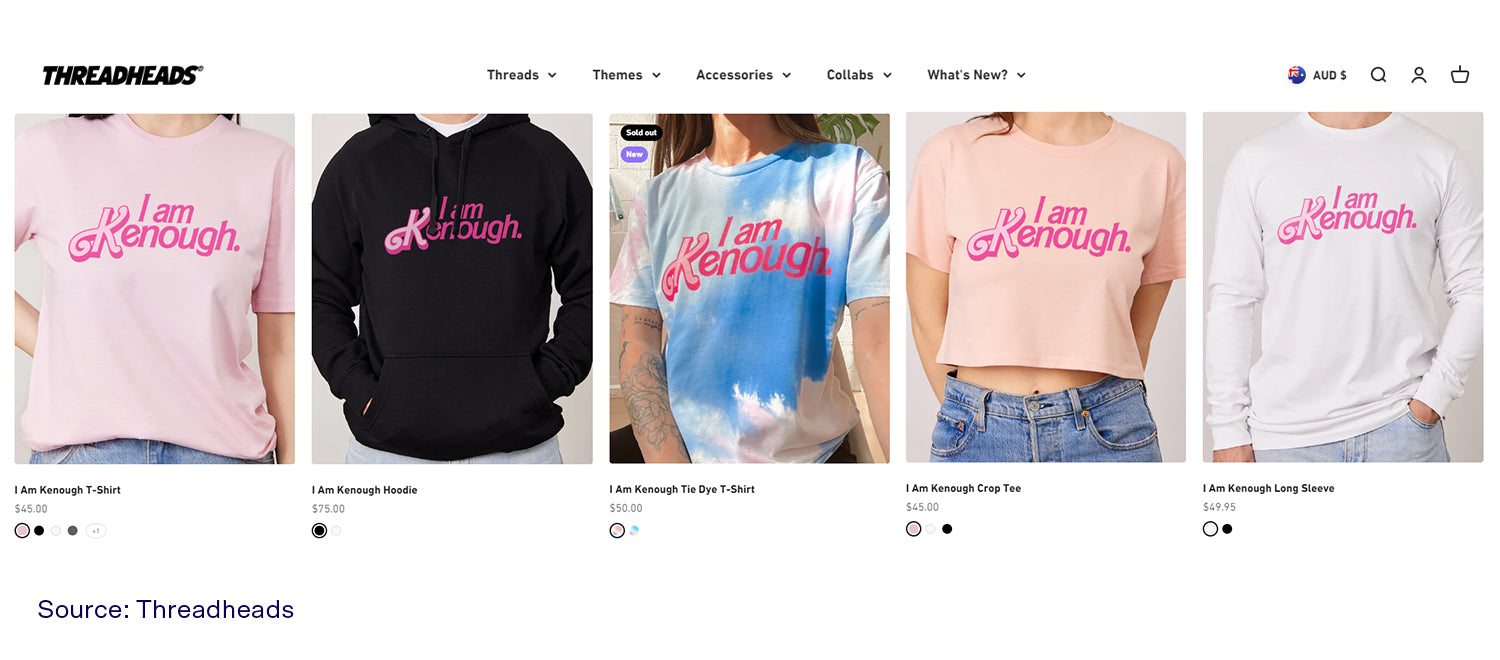
Independent artists looking to sell their artwork on clothing can rely on companies like Redbubble. This platform allows artists to create and upload their designs, which can then be printed on a variety of clothing and accessory options. The designs are only printed and shipped from third-party suppliers once a customer places an order, which means that artists don’t have to worry about maintaining physical inventory. This arrangement provides an excellent opportunity for artists to showcase their work and earn a profit without the need for upfront investment, just as the case for Dropshipzone Retailers.
These are just some examples of how custom-printed clothing is growing in popularity in Australia, making it the perfect option for dropshippers. When choosing print-on-demand suppliers, you should look out for crucial factors such as the quality of the product, fast shipping times, and affordable rates. By making an informed decision about suppliers, dropshippers can ensure that they provide their customers with the best possible shopping experience, encouraging brand loyalty.
4-step guide to dropshipping clothes successfully
1. Conduct clothing product research
Conducting market research is a crucial step in determining the level of demand for your products or services. Through this process, you can gain valuable insights into consumer preferences, identify potential gaps in the market, and gather feedback on how to improve your products. This allows you to make informed decisions regarding your business strategy and stay ahead of the competition.
You should start by defining who your target audience is going to be. By doing this, you can gain valuable insights into specific clothing niches, competitors, and what the most effective marketing strategies are. For example, if your target audience consists of women aged 20 to 30, you can begin to understand the brands they tend to shop with, their particular shopping preferences, and the social media platforms they use to discover new clothing trends. This level of knowledge will be invaluable to developing your business strategy and ensuring you are successful in this competitive landscape.
One valuable resource for identifying trends in the clothing industry is Google Trends. By searching for a specific term, such as knitwear, you can observe the regular seasonal patterns that occur throughout the year. Specifically, you can see regular seasonality trends throughout the winter and a lack of interest through the warmer months, giving you valuable insights into fluctuations in customer demand. With this information, you can plan your inventory and sales strategy accordingly, ensuring that you are offering the right products at the right time to maximise revenue and retain customer loyalty.
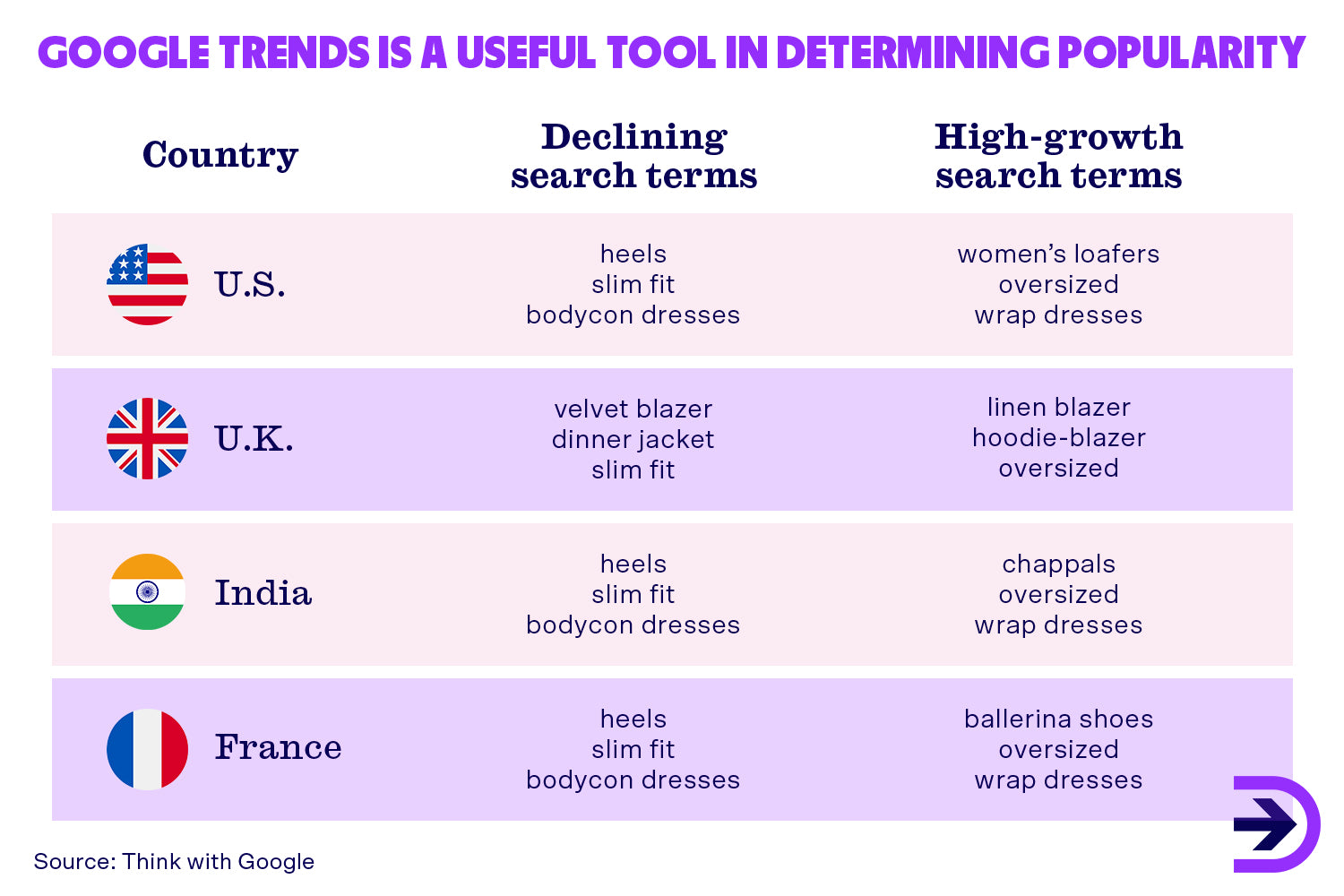
Another effective way for retailers to gain valuable insight into the shipping process and clothing quality is to order from potential suppliers and fellow competitors. This approach allows retailers to gather in-depth knowledge of the clothing fit and quality, which will be essential for you to confidently answer customer queries. By assessing the shipping process and clothing quality of other retailers, you can identify areas for improvement and discover ways to meet customer expectations.
2. Contact clothing dropshipping suppliers
Once you’ve decided on the type of products or niche you’re going to focus on, it’s time to start looking for suppliers. One of the best places to start is through a simple Google search. This will give you a good overview of suppliers available to you and the types of products they have on offer. As you browse through the search results, take note of suppliers that come across the most professional and have the best-rated products. Once you’ve identified the best suppliers, you can reach out and start contacting them. You can typically get in touch with suppliers via contact forms on their website, or through a phone number or email. Whichever method you choose, ensure you do so in a professional manner. This will help you build the foundations of a strong business relationship and make it easier to achieve great supplier relationship management.
From there, you can introduce yourself and detail the kinds of products you want to list on your website, and, if you can, a rough outline of how many orders you may expect on a monthly basis. Once the dropshipping clothing suppliers you have chosen get back to you and you are both happy to work with each other, you can start building a strategy and drawing up contracts and negotiations. Your clothing supplier may have minimum order requirements you need to meet, as well as minimum retail prices for their products. You’ll also want to make sure you are aware of return and exchange policies for faulty, unsatisfactory or damaged products, especially when dealing with clothing.
At Dropshipzone, we believe that dropshipping can be made simpler, and we have made it our mission to do just that. With access to thousands of SKUs from hundreds of trustworthy Australian Suppliers, our marketplace is the perfect solution for retailers who want to save time on supplier research and access new high-quality products daily. By joining our marketplace, you will be able to build your dropshipping store with ease and convenience, and our extensive product selection ensures that you will always be able to find whatever you need. Sign up today to start simplifying your dropshipping experience.

3. Build your dropshipping website
Now that you’ve decided on your clothing niche, target audience, and suppliers, you can start to build your online storefront. This will be the face of your online clothing store, so it’s important that you get it right. 94 per cent of first impressions are made with your website and its design, making this step of the process paramount to the profitability and success of your dropshipping business. Your website gives you a chance to showcase your range of products in an appealing way, filtering your clothing into product categories so your customers can find the perfect outfit anytime they need it.
Begin by choosing an ecommerce platform that coincides with your future business goals. Some of the best dropshipping platforms include the following:
Once you’ve decided on a platform, you can decide on a business and domain name that you feel encapsulates your clothing brand. A great domain name gives customers a snapshot of the kind of business you are, without being too long or wordy so customers can quickly read it. Then you can move onto the page layout of your website, and if you’ve chosen to build your website with a platform like Shopify, you’ll have plenty of creative themes to choose from, a lot of which are specifically made for clothing brands. Ensure your website is also compatible across laptops and mobile devices, as 45 per cent of consumers expect this from brands.
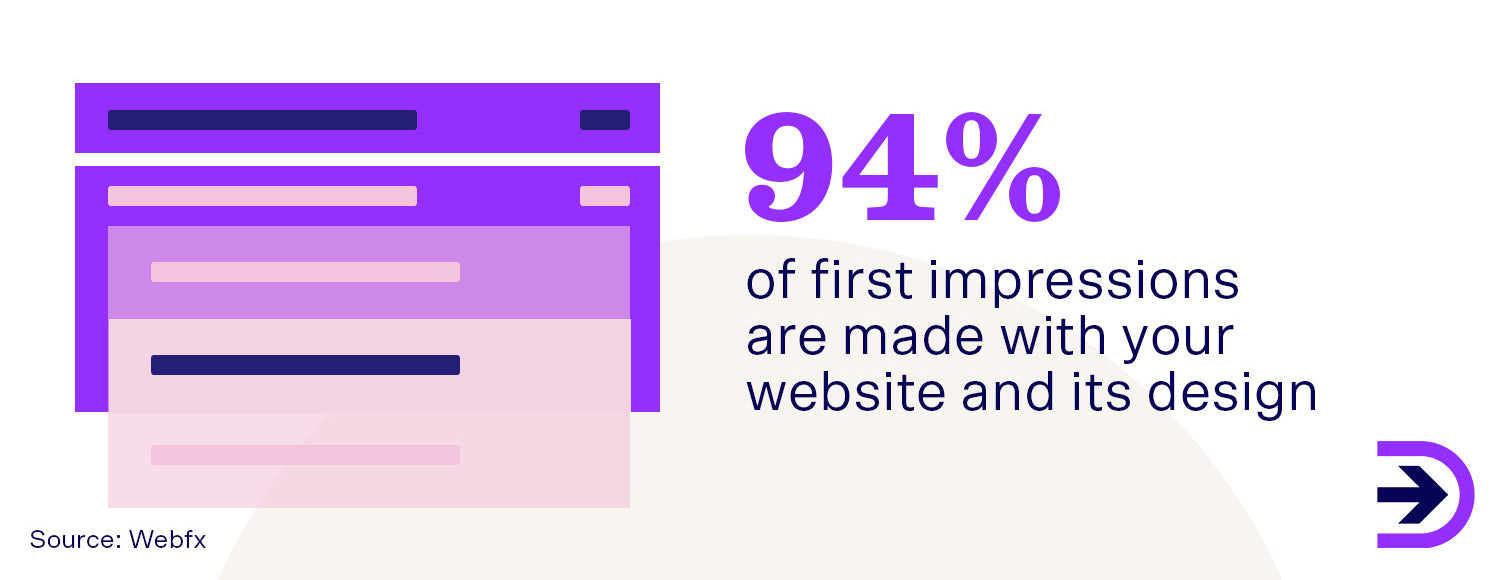
You should also consider using a plug-in to make product syncing easier and to automate fulfilment, this will save you a lot of time in the future. If you’re a Shopify user, Dropshipzone has exclusively developed a dropshipping app, Sofortig, to make importing your dropshipping products onto your website simple and easy.
4. Begin marketing your online store
To ensure that your clothing dropshipping business thrives, it's crucial to effectively market your products to potential customers. Begin by conducting thorough market research to determine the needs and preferences of your target audience. Once you have a clear understanding of their preferences, tailor your marketing efforts to appeal to them. This can include utilising social media platforms, email marketing, and other advertising techniques. By consistently promoting your products to the right audience, you'll increase your chances of success in this highly competitive market.
Email marketing is a digital strategy that has proven to be highly effective for businesses. In fact, research indicates that about two-thirds of marketers use it to inform their customers about new products, sales, and other important brand messages. You can also send alert notifications to customers when items are back in stock, increasing conversion rates. All of these can reduce cart abandonment and build customer loyalty, increasing conversion rates. With the right email marketing campaign in place, businesses can increase their engagement with customers and ultimately drive more sales.
Social media marketing is another highly effective and budget-friendly way to establish a direct connection with your target audience. Consistently posting on your social media accounts and incorporating product tags that facilitate easy shopping can see a significant increase in your brand's visibility. However, it's crucial to maintain a balanced approach by combining engaging content with promotional posts. You’ll find you get the best results when you find that sweet spot. Optimising your website with SEO and SEM strategies such as incorporating relevant keywords and creating informative blogs is an excellent way to increase organic traffic from search engines like Google, as being highly rated on Google can double your organic traffic.
Starting a dropshipping clothing business has never been easier with Dropshipzone. If you are seeking to expand your range of products or start an online business, join Dropshipzone today to take your business to the next level. Our platform is designed to simplify inventory management and customer acquisition, which are essential components of running a successful business. With Dropshipzone, you can easily source high-quality products from a variety of reputable Australian Suppliers, and seamlessly integrate them into your website.
